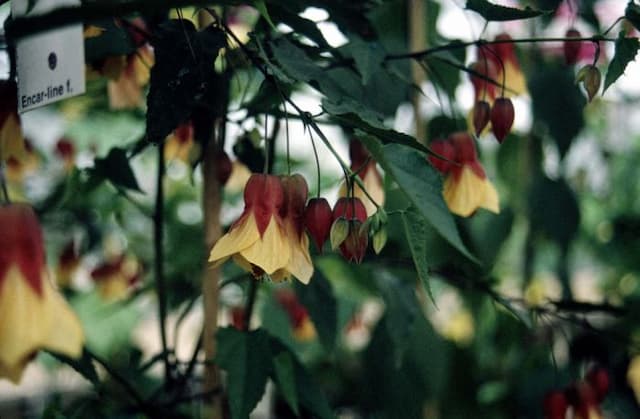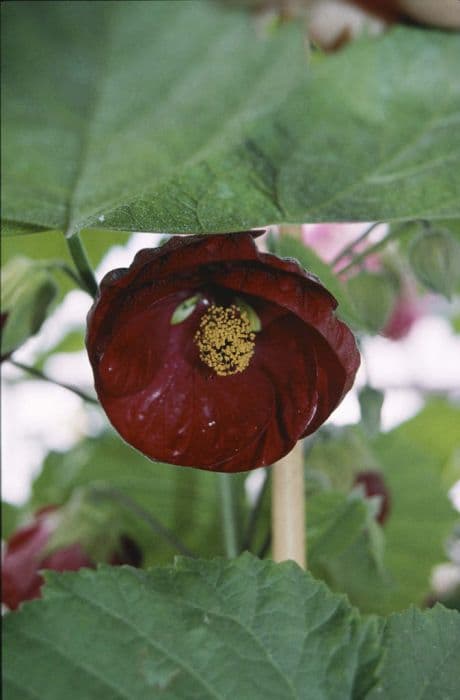Tree Mallow Lavatera × clementii 'Burgundy Wine'

ABOUT
The Lavatera × clementii 'Burgundy Wine', more commonly known as the 'Burgundy Wine' tree mallow, is a stunning ornamental plant. It features a lavish display of deep burgundy-colored blooms, which have a velvety texture and a striking appearance against the lush green foliage. The flowers are hibiscus-like in shape with a pronounced central stamen that adds to their allure. Each blossom is sizable and saucer-shaped, inviting to pollinators like bees and butterflies. This perennial showcases a profusion of these eye-catching flowers throughout its blooming season. The leaves of the 'Burgundy Wine' tree mallow have a soft, heart-shaped form with a somewhat serrated edge, carrying a subtle, matte finish that complements the vivid flowers. These leaves are artfully arranged on the branches, creating a dense and bushy growth habit that adds to the overall visual impact of the plant. Its overall appearance is one of elegance and vibrant color, making it a popular choice for gardeners looking to add a touch of drama to their landscape.
About this plant
 Names
NamesFamily
Malvaceae.
Synonyms
Tree Mallow, Rose Mallow, Shrubby Mallow, Lavatera 'Burgundy Wine'.
Common names
Lavatera × clementii 'Burgundy Wine'
 Toxicity
ToxicityTo humans
The Lavatera, commonly known as mallow, is not considered highly toxic to humans. There is limited information on severe poisoning from ingestion of this plant. However, as with many plants, individual allergies or sensitivities might exist. In these rare cases, ingestion could potentially cause mild gastrointestinal symptoms such as nausea, vomiting, or diarrhea. It is always advisable to exercise caution and keep plants out of reach of young children who might ingest them out of curiosity.
To pets
The Lavatera, or mallow, is not commonly listed as a toxic plant to pets such as dogs and cats. However, individual animals might have sensitivities to plants that are not considered broadly toxic to all pets. If a pet ingests a large quantity of this plant, it might experience mild gastrointestinal upset, including symptoms like vomiting or diarrhea. As with any non-food plant material, it is prudent to prevent pets from consuming them to avoid potential issues. If you notice your pet displaying adverse reactions after consuming any part of the mallow, it is recommended to contact your veterinarian.
 Characteristics
CharacteristicsLife cycle
Perennials
Foliage type
Deciduous
Color of leaves
Green
Flower color
Burgundy
Height
6 feet (1.8 meters)
Spread
4 feet (1.2 meters)
Plant type
Shrub
Hardiness zones
6
Native area
Mediterranean
Benefits
 General Benefits
General Benefits- Aesthetic Appeal: The Lavatera × clementii 'Burgundy Wine', also known as Tree Mallow, showcases eye-catching burgundy flowers that enhance the beauty of any garden or landscape.
- Attracts Pollinators: Its vivid flowers attract a variety of pollinators, including bees and butterflies, supporting biodiversity.
- Drought Tolerance: Once established, the Tree Mallow is drought-tolerant, making it a suitable choice for water-wise gardens.
- Fast Growth: This plant is known for its fast growth rate, which quickly creates impact and fills in garden spaces.
- Easy Care: The Tree Mallow is generally low maintenance and does not require complex gardening skills to thrive.
- Versatility: It can be used in mixed borders, as hedging or as a stand-alone specimen, offering versatility in landscaping.
- Extended Blooming: With a long blooming period, this plant provides prolonged interest throughout the growing season.
 Medical Properties
Medical PropertiesThis plant is not used for medical purposes.
 Air-purifying Qualities
Air-purifying QualitiesThis plant is not specifically known for air purifying qualities.
 Other Uses
Other Uses- Textile Dyeing: The deep burgundy color of the flowers from Lavatera may be used in natural dyeing processes to impart color to fabrics.
- Ink Production: Similarly, pigment extracted from the 'Burgundy Wine' flowers can be used to make natural inks for art and writing.
- Photography: The vibrant and contrasting colors of the Lavatera make it an excellent subject for botanical photography and garden portfolios.
- Craft Projects: Dried Lavatera blooms can be incorporated into paper making or used in potpourri and other craft projects for color and decoration.
- Garden Borders: Due to its dense foliage and striking colors, Lavatera can serve as a natural and attractive border for garden paths and property lines.
- Companion Planting: The plant can be used in gardens to attract beneficial insects that help pollinate other plants or keep pests at bay.
- Culinary Garnish: Although not commonly consumed, the flowers may be used as a colorful garnish for special dishes in high-end culinary presentations.
- Educational Tool: Lavatera plants can be used in schools or educational programs to teach about plant biology, including flower structure and pollination.
- Weddings and Celebrations: The flowers can be used in floral arrangements, bouquets, or as venue decoration for weddings and special events.
- Soil Erosion Control: When planted in groups, Lavatera can help stabilize soil and prevent erosion in sloped gardens or areas prone to soil degradation.
Interesting Facts
 Feng Shui
Feng ShuiThe Tree Mallow is not used in Feng Shui practice.
 Zodiac Sign Compitability
Zodiac Sign CompitabilityThe Tree Mallow is not used in astrology practice.
 Plant Symbolism
Plant Symbolism- Beauty and Softness - The Lavatera, often referred to as "Tree Mallow," typically has soft, velvety leaves and large, striking flowers, which can symbolize beauty and an inviting softness.
- Resilience - 'Burgundy Wine' is a robust plant that can thrive in a variety of conditions, symbolizing the ability to endure and grow in adversity.
- Femininity - With its lush, softly colored blooms, the Tree Mallow is sometimes associated with feminine qualities such as tenderness and grace.
- Love and Fertility - The prolific flowering of the Tree Mallow, particularly the 'Burgundy Wine' variety, can represent abundance in love and the potential for new beginnings.
- Regeneration - As a plant that can quickly regenerate after pruning, the Lavatera 'Burgundy Wine' symbolizes renewal and the cyclical nature of life.
- Protection - Historically, mallows were believed to have protective properties, and this symbolism can extend to the Lavatera 'Burgundy Wine' as a guardian of one's surroundings.
 Water
WaterThe Tree Mallow prefers consistent moisture, so water when the top inch of soil feels dry to the touch. This generally means watering about once a week, but frequency can vary with environmental conditions. During hot or windy weather, it may need water twice a week, while in cooler, cloudier conditions, every ten days may be sufficient. Apply water directly to the base of the plant to avoid wetting the leaves and provide a deep soak, using approximately 1-2 gallons per watering session for an established plant to ensure that moisture reaches the root zone.
 Light
LightThe Tree Mallow thrives in full sun to partial shade, preferring at least six hours of sunlight per day. The best spot for this plant would be an area that receives unfiltered sunlight for the majority of the day, such as a south or west-facing garden bed. In regions with very hot summers, some afternoon shade can help protect the plant from heat stress.
 Temperature
TemperatureTree Mallows are hardy and flourish in a wide range of temperatures, but they perform best in temperatures between 50 and 80 degrees Fahrenheit. They can survive short periods of colder weather down to about 20 degrees Fahrenheit and can tolerate heat well into the 90s, but extended periods of extreme temperatures can stress the plant.
 Pruning
PruningTree Mallows should be pruned to maintain their shape and encourage bushier growth. The best time for pruning is in late winter or early spring before new growth begins. Cut back the previous year's growth by about one-third to one-half to stimulate new shoots. Remove any dead or damaged wood as needed throughout the year.
 Cleaning
CleaningAs needed
 Soil
SoilTree Mallow 'Burgundy Wine' prefers well-draining, fertile soil with a pH range of 6.0 to 8.0. A mix with equal parts loam, peat, and sand or perlite encourages healthy growth. Ensure organic matter like compost is added to enrich the soil.
 Repotting
RepottingTree Mallow 'Burgundy Wine' should be repotted every 2-3 years, or when it outgrows its current container. Spring is the best time for repotting to allow the plant to establish in the growing season.
 Humidity & Misting
Humidity & MistingTree Mallow 'Burgundy Wine' prefers moderate humidity levels but is tolerant of a range of conditions. It does not have specific humidity requirements and can adapt to the ambient outdoor humidity.
 Suitable locations
Suitable locationsIndoor
Ensure bright light and space, avoid excess heat.
Outdoor
Needs full sun, shelter from strong winds.
Hardiness zone
6-9 USDA
 Life cycle
Life cycleThe life of 'Burgundy Wine' Tree Mallow generally begins with seed germination, which occurs in warm, moist soil conditions of spring after the threat of frost has passed. The seedlings then grow rapidly, developing a robust root system and foliage. As a perennial, it enters a vegetative state where it grows to its full height and spread, typically reaching about 6-8 feet tall, and features its notable deep burgundy flowers throughout the summer months. After flowering, it sets seeds that can disperse in the environment, ensuring future generations. During the autumn, the plant begins to die back with the onset of cooler temperatures and shorter days, preparing to enter a state of dormancy through the winter. In spring, the plant will emerge from dormancy to start a new growth cycle, continuing this process for several years depending on the climate and conditions in which it grows.
 Propogation
PropogationPropogation time
Spring-Early Summer
Propogation: The most popular method of propagating Lavatera × clementii 'Burgundy Wine', commonly known as Burgundy Wine Mallow, is through softwood cuttings. This process typically takes place in the late spring or early summer when new growth is soft and pliable. Cuttings should be about 4 to 6 inches long, with several leaves remaining at the top. The lower leaves are removed, and the base of the cutting is dipped in rooting hormone powder to encourage root development. Then, the cuttings are planted in a well-draining potting mix and kept moist until roots develop, which usually happens within a few weeks. Careful attention to maintaining humidity around the cuttings by covering them with a plastic bag or placing them in a greenhouse environment can greatly enhance the success rate.









